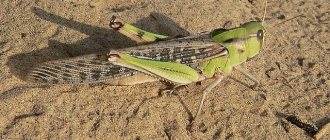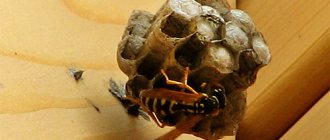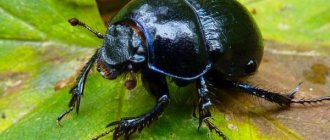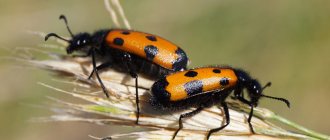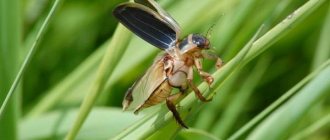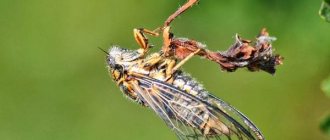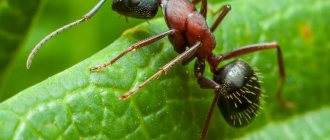- Wild animals
- >>
- Insects
Locusts are one of the most dangerous insects for the national economy. The pest of agricultural and wild crops is widespread throughout the planet. Once upon a time, in ancient times, locust raids not only destroyed crops, but could lead to starvation of an entire people. A single individual is completely harmless, but when it joins the ranks of a flock, it easily destroys all crops in its path.
Locust coloring
The color of locusts depends on the environment in which they live. Even individuals of the same offspring can differ in color. Ways of living alone have brighter colors.
If such an individual enters the herd, it acquires a color characteristic of the entire herd. Also, pronounced sexual characteristics disappear in the herd.
Nutrition
Single individuals do not cause catastrophic damage to green spaces. Singles have a very moderate appetite. During their entire life, they eat no more than five hundred grams of green mass. The main problem is the locusts that have united in a swarm.
To replenish the energy balance and vitality, individuals gathered in a herd are forced to eat without stopping, otherwise they will die from thirst and lack of protein. The locust, finding itself in the company of numerous relatives, begins to show amazing gluttony. One individual is capable of absorbing about four hundred grams of green mass per day, but there are millions of them in a flock.
With a lack of protein in the body, insects begin to degenerate into predators, and the process of eating their own kind begins. In this case, the flock is divided into two symbolic subgroups, one of which runs ahead, and the second tries to catch up and eat. Both those escaping and those catching up eat everything in their path, completely destroying crops and gardens.
Locusts are pests . The multimillion-dollar community will leave behind bare ground with the occasional remnant of protruding stems. Individuals have a better appetite in the absence of heat (morning and evening).
Distinctive features of locusts
Let's look at how to distinguish a locust from a grasshopper:
- The locust's antennae are much shorter than those of the grasshopper;
- the locust's legs are also shorter than those of the grasshopper;
- locusts are active during the day, and grasshoppers are active at night;
- grasshoppers are harmless, but locusts harm agricultural crops;
- grasshoppers are predatory insects, and locusts feed on plant foods.
What plants does it affect?
The pest is unpretentious in food , it eats the ground parts of vegetable plants, cereals, melons, attacks orchards, berry fields, wild trees, not disdaining reed plants.
Leaves, stems, shoots, even the bark of young trees serve as food .
You can learn more about the taste preferences of the merciless insect in the section devoted to its nutrition.
Interesting ! The older an insect gets, the more varied the food it eats becomes. Seasoned individuals are practically omnivorous.
The benefits and harms of locusts
In many countries, locusts are eaten.
Swarms of locusts are a dangerous pest of all plants. After the invasion of a swarm of locusts, nothing remains of vegetation. Adult insects eat all ground green spaces, and the larvae destroy plant roots.
Kinds
The most famous types of locusts are:
1. Migratory or Asian.
It is found in large quantities in European countries and in countries located in western Asia, in the Mediterranean territories of the African continent, in the countries of East Asia. The size of the body in an adult individual is usually 40-60 mm.
The wings have a barely noticeable grayish tone and darkened veins. The color follows the shades of the surrounding area - emerald-greenish, grayish-brownish or sand. The hind limbs of these insects are darker in color compared to the body.
2. Moroccan.
This species is distributed in the Mediterranean climate zone of northern Africa. You can see insects in the southern part of European countries, as well as countries located on the Balkan Peninsula and in southern Russia.
Adults are not large in size, in most cases they are no more than 20 mm, the color is usually inconspicuous, grayish-brownish. A distinctive feature by which they can be recognized is a light-colored pattern resembling a cross on the back and dark spots randomly located throughout the body.
3. Italian.
The main place of settlement is the countries of the Iberian and Apennine Peninsulas. You can meet insects in areas west of the Urals and in Asian countries, in the Altai Territory and in the countries of the Arab East.
The maximum size to which an adult insect grows is 40 mm. Individuals of the Italian locust have a brick or brownish color; lightish specks or stripes are clearly visible on the back.
4. Siberian filly.
It can be found in almost all regions of the Asian part of the Russian Federation (except for permafrost areas) and in Kazakhstan. A large number of Siberian fillies can be found in the northern territories of Mongolia and China, and the mountainous areas of the Caucasus. Mature individuals are relatively modest in size; their length is not often more than 25 mm. The color of the insects is brown with a brownish tint or a khaki shade.
5. Egyptian filly.
This species can be found in European countries, northern regions of the African continent, and Middle Eastern countries. This is one of the most impressive insects. Females can grow up to 60-70 mm. Male individuals are smaller, their body size is no more than 40-45 mm.
These locusts are usually painted the color of a mouse or the color of wet sand. The hind legs of the insect have a bluish tint, sometimes with the addition of yellow-red. A characteristic feature is clearly visible lines - black and white, they can be seen on the bulging eyes.
6. Blue-winged filly.
It lives in steppes and forest-steppe regions of Asia and Europe, the Caucasus, western regions of Siberia and Kazakhstan. Does not apply to species whose size is large. 20 mm is all that a pest with beautiful wings can grow to. The color of the insect is amazing.
The wings have a turquoise or rich blue color, on which a fancy pattern of thin strokes of dark color is clearly visible. The hind legs have small spines of a light shade and are tinted light blue.
7. Rainbow Locust.
Lives on the island of Madagascar. This is a very spectacular and attention-grabbing individual, but at the same time, it is extremely poisonous. All her organs are literally saturated with toxic and noxious substances, since she only eats plants that produce poisonous juice.
Favorite food is milkweed leaves and fruits. Her appearance is admirable - the whole range of colors is gathered on her wings, and this is understandable, because she lives among bright vegetation. The beauty has impressive dimensions - up to 70 mm.
Ways to fight
If there are not many pests, mechanical cleaning can be used. It is necessary to collect and destroy the larvae in the soil; this is effective only in the early stages.
Digging. It does not always bring results, since it is not possible to remove all the larvae. It is more effective when introducing chemicals to destroy egg laying.
Burning out. In this way you can get rid of clutches of eggs that are shallow in the soil. To increase the depth of heating, the soil surface is covered with straw or peat. To increase the effect, the soil is dug up so that the remaining larvae die during the winter.
Chemical treatment. In specialized stores you can purchase special compounds suitable for locusts. Treatment is carried out in early spring before sowing, since chemical treatment negatively affects the quality of grown products.
Locusts are quite resistant to chemicals, so the plants they feed on are treated. But even the most powerful poisons cannot always get rid of pest infestations.
Timely preventive and protective actions will help save your harvest.
Habitat
There are a huge number of locust species, and about 600 of them live in Russia, mainly in the southern regions. The steppe locust lives in Asia, North Africa, and Europe. Different species live in different regions. The borders of the Sahara, the Indo-Malayan archipelago, New Zealand, Kazakhstan, Siberia, Madagascar are all habitats for locusts.
Large nesting centers are located in the delta of the Amu Darya River, near the Northern Caspian Sea and Dagestan. The northern regions are also habitats for locusts, but the population density there is much lower than in the south. The insect pest locust prefers dryness and heat, so it often settles in semi-deserts and dry steppes.
Small flocks fly 20-40 km per day, and large flocks can travel 200 km. Per day. The southern regions of Russia have repeatedly suffered from locust invasions. So in 2010, the Astrakhan region almost lost 50 hectares of crops, and in the Volgograd region, locusts caused damage to 12 districts. People are fighting locusts, but it is very expensive.
Photo of locusts
Description
The body is large, 3.5–5.5 cm in length, from green to brown, covered with small brown spots. The length of the elytra in males is 43–56 mm, in females 49–61 mm. The solitary phase, unlike the gregarious one, does not have a constriction on the pronotum, but it is compressed laterally, its anterior edge is angular (and not rounded, like the gregarious one), and the middle crest is high and arched. The hind tibiae of the solitary phase are bright red, while those of the gregarious phase are yellowish.
Adult female solitary phase, Genoa, Italy
Adults of the gregarious phase (southern France)
Reproduction
The males begin the love games of locusts. They secrete a special enzyme that can attract females. Jumping onto the female, the male deposits a spermatophore at the base of the female's ovipositor. This process can take up to 14 hours. After fertilization, the female locust lays eggs in the ground or on fallen leaves, enveloping them in a special liquid that freezes and hardens. Thus, the clutch is protected throughout the entire period of egg maturation.
Each locust cocoon contains from 50 to 150 eggs. The female lays from 6 to 12 clutches during her life. There can be up to 2000 cocoons per square meter. The offspring of locusts go through three stages of development: egg, larva, and adult. After winter, larvae emerge from the eggs, similar to adult locust insects only without wings.
Forty days after five molts, a full-fledged locust individual develops from the larva, capable of producing new offspring. The lifespan of the pest ranges from 8 months to 2 years.
On a note!
In warm regions and subtropics, locusts develop throughout the year. After 14-16 days, a new generation appears, ready to actively move and reproduce.
How to identify an insect?
In order to determine which superfamily an insect belongs to, it is necessary to know the description of its main body parts. Conventionally, it is divided into three parts - head, chest and abdomen. It is necessary to carefully examine and pay attention to the distinctive features of the insect, namely: the size, type and length of the antennae and limbs. To identify an individual, you can turn to an electronic identification guide, which will tell you how to correctly distinguish a grasshopper from a locust.
Tables for determination
The key consists of various tables in which the type of family members can be determined by complex external characteristics. Using these tables, you can easily identify the identity of the insect. The determinant indicates the characteristic features with the assignment of numbers. Numbers in brackets indicate opposite features. You can conduct a visual inspection of the insect and follow from one sign to another. For example, the presence of a mustache or other features.
By looking for external features, you can achieve your goal - to determine the species. Next to the name in Latin there will be an inscription with the name of the family in Russian. By clicking on the link, you can see a color image of the insect and specify the name. If the data that you found in the key matches the external characteristics of the insect, then the identification of the species of the individual (locust or grasshopper) can be considered successful.
Thus, it is not so difficult to correctly distinguish a pest from a predator found in a garden plot. Knowing the structural features of the body will help determine the species. If in doubt, you can use an electronic identifier to help identify the insect.
Taxonomy
The only species in the genus Locusta, identified by Carl Linnaeus in his work “System of Nature” in 1758. Based on morphological characteristics, up to 11 subspecies are distinguished, although not all researchers agree with this classification. Genetic research is at an early stage, but is already in conflict with morphological analysis.
Subspecies:
- L.m. capito - Madagascar
- L.m. cinerascens
- L.m. manilensis - East Asia
- L.m. migratoria - Western and Central Asia, Eastern Europe, Russia
- L.m. migratorioides - Africa and the Atlantic Islands
- L.m. gallica
- L.m. rossica – Russia
L.m. cinerascens, male, Genoa, Italy
L.m. migratorioides, fifth instar larva (L5), solitary phase, Red Sea coast, Sudan
Lifestyle
The main “reservoir” populations live in floodplain meadows of large river deltas. As the number of individuals in the population increases, the nervous system of the larva perceives their signals and switches development to the gregarious phase: a brighter brown-red larva instead of green. The switching involves the mechanisms of neural plasticity and hormones.
L.m. migratoria, female, nymph in the background
